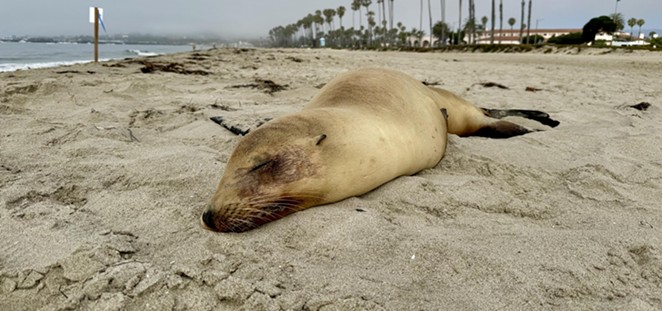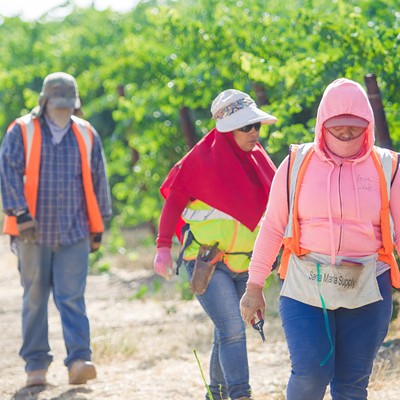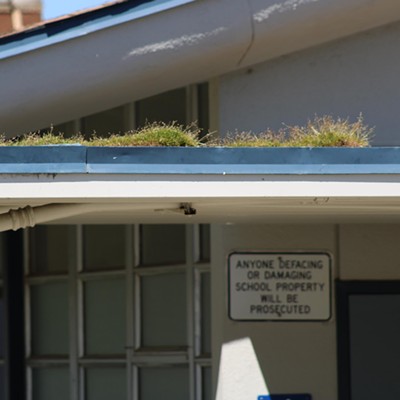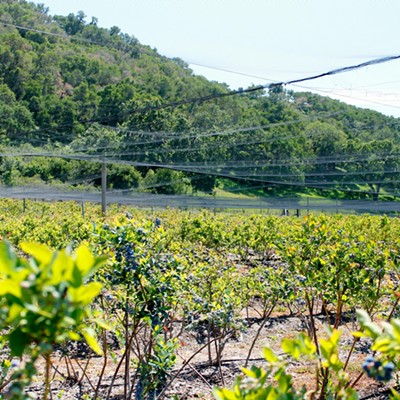Mouth foaming. Lethargic and erratic behavior. Muscle spasms. Seizures. Death.
Up and down Central Coast beaches, sea lions are suffering the effects of domoic acid poisoning—a neurotoxin produced by a harmful algal bloom that comes around every few years, possibly because of climate change and runoff impacts, Dr. Sam Dover told the Sun.
“Sea lions are sentinel species, they tell us what’s occurring in the environment. They are the canary in the coal mine, so to speak, of the ocean,” Dover said.
While scientists still don’t know for certain what causes the algae bloom, many theorize it’s because of upwellings—when cold, nutrient-rich water deep in the ocean gets pushed to the surface—warmer water temperatures; and/or sewage, agriculture, or freshwater runoff entering the ocean, he said.
“It’s human-related for sure. It’s an indicator that we’re not doing a very good job. We can’t control the upwelling, but we can control the pollution, the runoff. It’s an indicator that the environment is getting hit harder and harder every year,” Dover said.
Filter-feeding animals like mollusks, clams, oysters, and scallops consume the algae but experience no harmful effects. However, marine mammals, mostly sea lions, that consume high amounts of fish can get sick from the algae or die, Dover said.
The Channel Islands Marine and Wildlife Institute rescues and rehabilitates sick marine mammals in Santa Barbara and Ventura counties. Animals in SLO County and Morro Bay have also been impacted, he added.
This is the institute’s third consecutive year responding to domoic acid poisoning-related issues. As of Aug. 8, the institute has seen about 10 animals per day on average and has rescued about 52 sick sea lions as of Aug. 8. More than 30 have died due to the poisoning’s effects, he said.
“We’re only two weeks into this one,” Dover said on Aug. 9. “Last summer was more intense than this one, but none of them were fun.”
In 2023, the institute responded to calls for 651 marine mammals exhibiting signs of domoic acid poisoning and rescued 97 sea lions along with encountering several dolphins that died after beaching because of the poisoning, according to the institute.
“Fortunately or unfortunately our volunteers are kind of used to it now, not in a good way,” Dover said. “It does take a toll; a lot of our volunteers get fatigued from it because if an animal dies there’s nothing we can do.”
Vandenberg Space Force Base also reported an uptick in sea lions stranded at Surf Beach and other beaches both on and off the base. The base is collaborating with the institute to respond to animals and complete testing, according to a July 30 Vandenberg press release.
The California Department of Public Health (CDPH) issued an advisory on Aug. 8 warning people not to consume sport-harvested mussels, clams, scallops, oysters, crabs, and lobster from Santa Barbara County because of high domoic acid levels. The advisory does not apply to commercially sold shellfish because certified harvesters are subject to mandatory testing and toxin monitoring.
The toxin can cause Amnesic Shellfish Poisoning in humans where they experience vomiting, diarrhea, abdominal cramps, headaches, and dizziness. In severe cases, a person might experience trouble breathing, confusion, disorientation, heart issues, or seizures.
“The naturally occurring domoic acid toxin can cause illness or death in humans. Cooking does not destroy the toxin,” according to CDPH.
If an animal has a small dose of the toxin, volunteers and veterinarians will give the mammals an IV and over-hydrate them to flush the toxins out of their system. The Channel Islands Marine and Wildlife Institute will release them if they show signs of improvement, Dover said.
“We can also treat them with anti-seizure medication. The brain damage, the prognosis of animals with seizures is not good at all,” Dover said. “We also know there’s really limited treatment you can provide that’s actually going to work. Because of all that, most organizations are doing the same; we try on the ones that look like they might have a chance, but a lot of them will die.”














